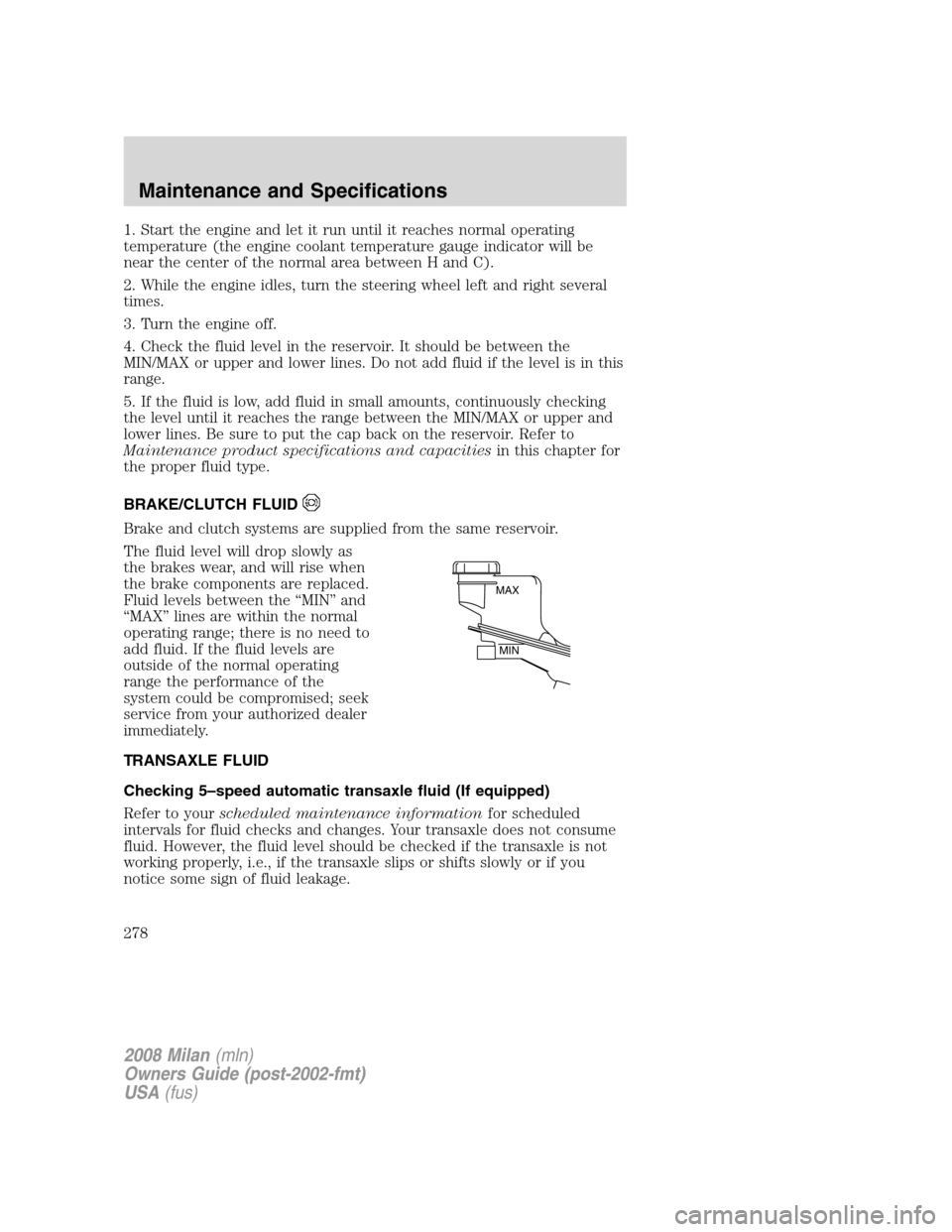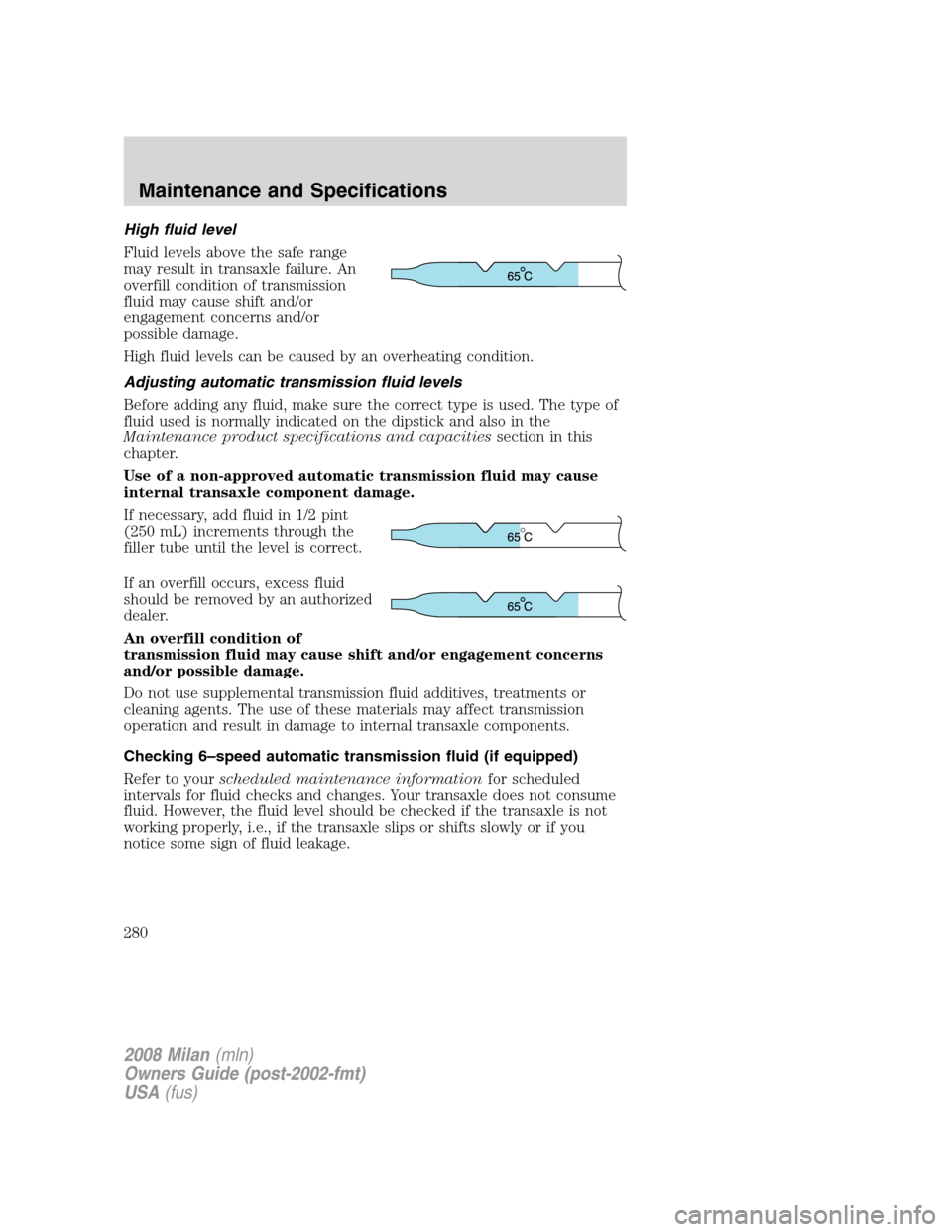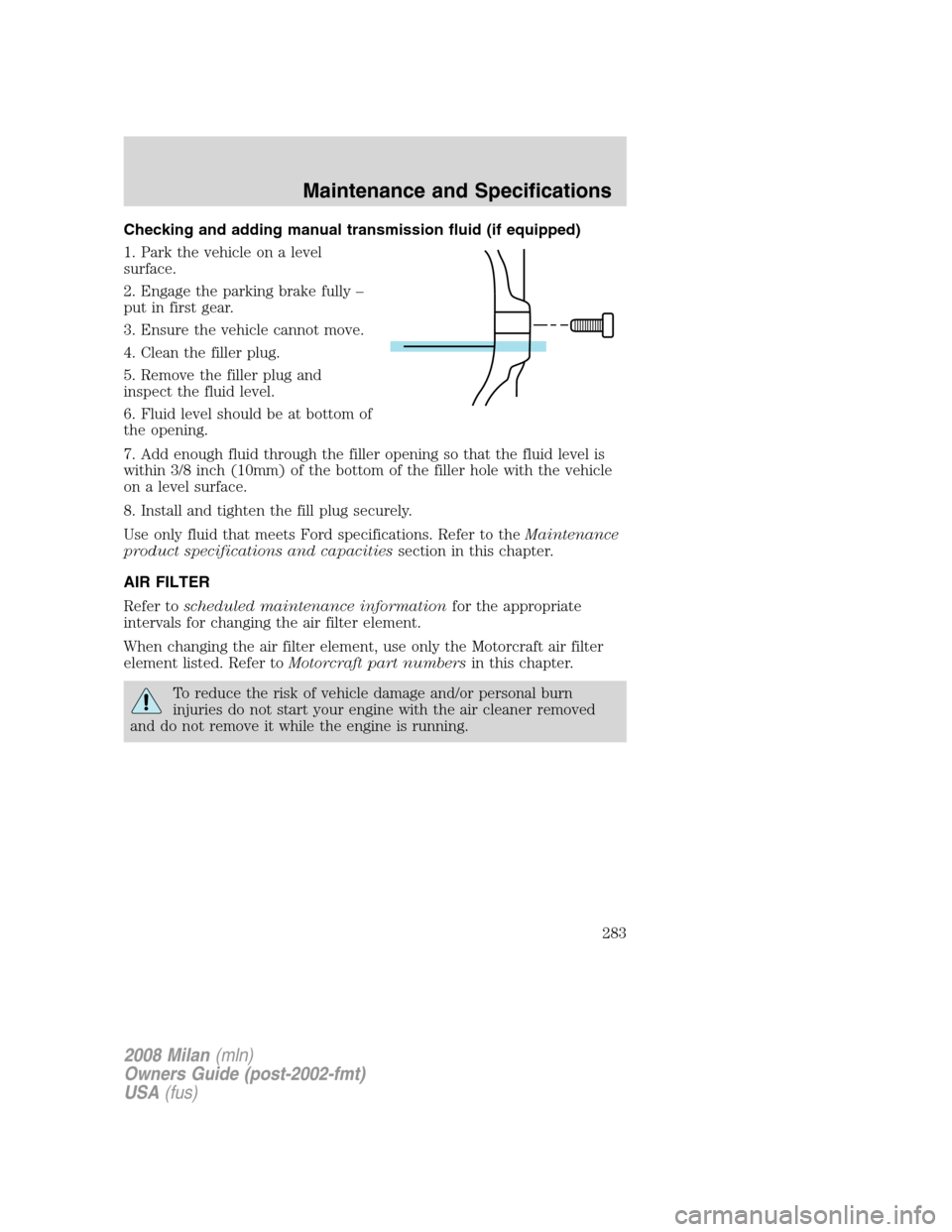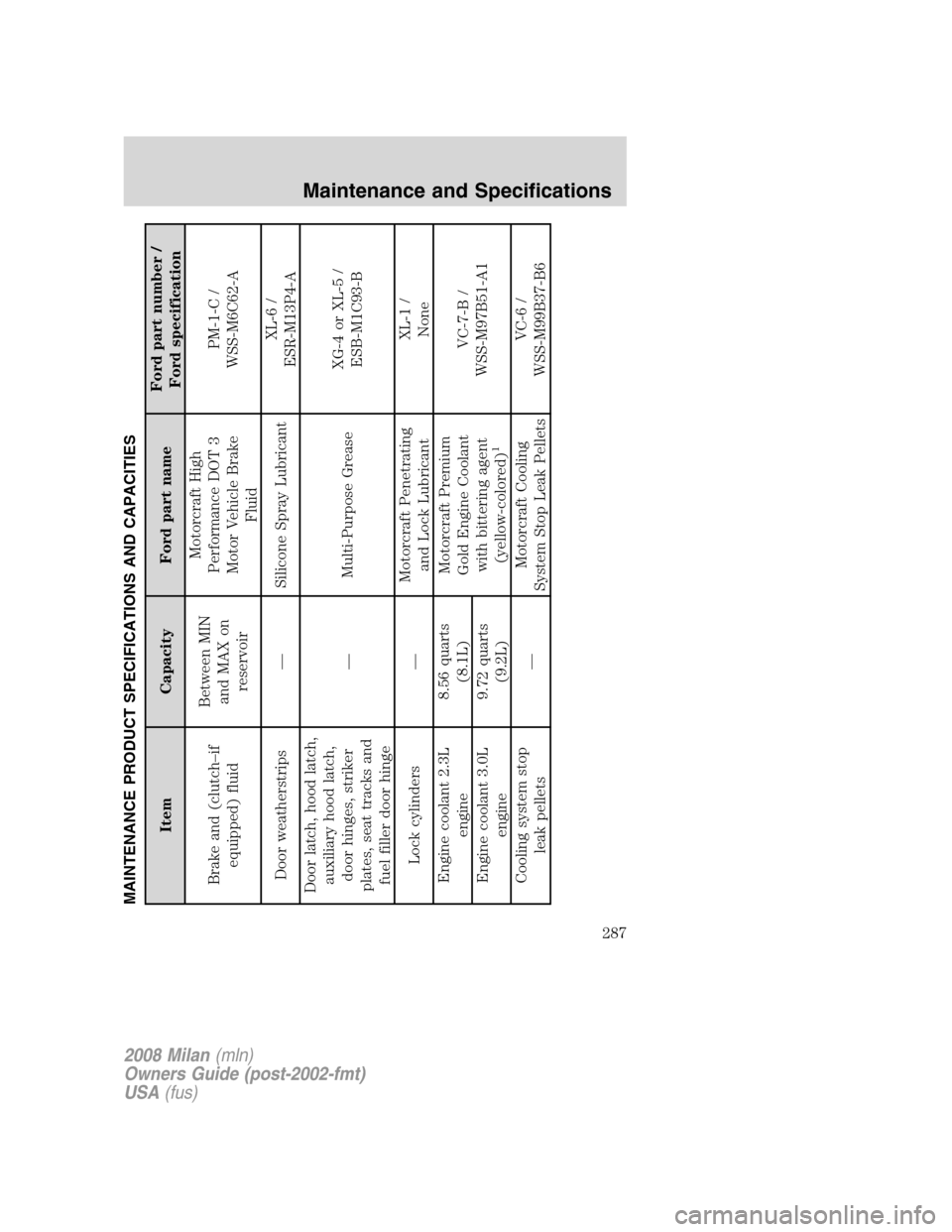Product and specifications Mercury Milan 2008 s User Guide
[x] Cancel search | Manufacturer: MERCURY, Model Year: 2008, Model line: Milan, Model: Mercury Milan 2008Pages: 304, PDF Size: 2.83 MB
Page 278 of 304

1. Start the engine and let it run until it reaches normal operating
temperature (the engine coolant temperature gauge indicator will be
near the center of the normal area between H and C).
2. While the engine idles, turn the steering wheel left and right several
times.
3. Turn the engine off.
4. Check the fluid level in the reservoir. It should be between the
MIN/MAX or upper and lower lines. Do not add fluid if the level is in this
range.
5. If the fluid is low, add fluid in small amounts, continuously checking
the level until it reaches the range between the MIN/MAX or upper and
lower lines. Be sure to put the cap back on the reservoir. Refer to
Maintenance product specifications and capacitiesin this chapter for
the proper fluid type.
BRAKE/CLUTCH FLUID
Brake and clutch systems are supplied from the same reservoir.
The fluid level will drop slowly as
the brakes wear, and will rise when
the brake components are replaced.
Fluid levels between the “MIN” and
“MAX” lines are within the normal
operating range; there is no need to
add fluid. If the fluid levels are
outside of the normal operating
range the performance of the
system could be compromised; seek
service from your authorized dealer
immediately.
TRANSAXLE FLUID
Checking 5–speed automatic transaxle fluid (If equipped)
Refer to yourscheduled maintenance informationfor scheduled
intervals for fluid checks and changes. Your transaxle does not consume
fluid. However, the fluid level should be checked if the transaxle is not
working properly, i.e., if the transaxle slips or shifts slowly or if you
notice some sign of fluid leakage.
MAX
MIN
2008 Milan(mln)
Owners Guide (post-2002-fmt)
USA(fus)
Maintenance and Specifications
278
Page 280 of 304

High fluid level
Fluid levels above the safe range
may result in transaxle failure. An
overfill condition of transmission
fluid may cause shift and/or
engagement concerns and/or
possible damage.
High fluid levels can be caused by an overheating condition.
Adjusting automatic transmission fluid levels
Before adding any fluid, make sure the correct type is used. The type of
fluid used is normally indicated on the dipstick and also in the
Maintenance product specifications and capacitiessection in this
chapter.
Use of a non-approved automatic transmission fluid may cause
internal transaxle component damage.
If necessary, add fluid in 1/2 pint
(250 mL) increments through the
filler tube until the level is correct.
If an overfill occurs, excess fluid
should be removed by an authorized
dealer.
An overfill condition of
transmission fluid may cause shift and/or engagement concerns
and/or possible damage.
Do not use supplemental transmission fluid additives, treatments or
cleaning agents. The use of these materials may affect transmission
operation and result in damage to internal transaxle components.
Checking 6–speed automatic transmission fluid (if equipped)
Refer to yourscheduled maintenance informationfor scheduled
intervals for fluid checks and changes. Your transaxle does not consume
fluid. However, the fluid level should be checked if the transaxle is not
working properly, i.e., if the transaxle slips or shifts slowly or if you
notice some sign of fluid leakage.
2008 Milan(mln)
Owners Guide (post-2002-fmt)
USA(fus)
Maintenance and Specifications
280
Page 282 of 304

Low fluid level
Do not drive the vehicle if the fluid
level does not show at all on the
dipstick.
Driving the vehicle with less than
the recommended fluid level may result in transaxle failure. An under fill
condition of transmission fluid may cause shift and/or engagement
concerns and /or possible damage to the transaxle.
High fluid level
Fluid levels above the normal
operating range may result in
transaxle failure. An overfill
condition of transmission fluid may
cause shift and/or engagement
concerns and/or possible damage to
the transaxle.
High fluid levels can be caused by an overheating condition.
Adjusting automatic transmission fluid levels
Before adding any fluid, make sure the correct type is used. The type of
fluid used is normally indicated on the dipstick and also in the
Maintenance product specifications and capacitiessection in this
chapter.
Note:Only one ATF fluid specification has been tested and approved for
use with the automatic 6-speed: Premium Automatic Transmission fluid.
Mercon fluids cannot be used with the automatic 6-speed without
damage or voiding warranty.
Use of a non-approved automatic transmission fluid may cause
internal transaxle component damage.
If necessary, add fluid in 1/2 pint (250 mL) increments through the filler
tube until the level is correct.
If an overfill occurs, excess fluid should be removed by an authorized
dealer.
An overfill condition of transmission fluid may cause shift and/or
engagement concerns and/or possible damage.
Do not use supplemental transmission fluid additives, treatments or
cleaning agents. The use of these materials may affect transmission
operation and result in damage to internal transaxle components.
2008 Milan(mln)
Owners Guide (post-2002-fmt)
USA(fus)
Maintenance and Specifications
282
Page 283 of 304

Checking and adding manual transmission fluid (if equipped)
1. Park the vehicle on a level
surface.
2. Engage the parking brake fully –
put in first gear.
3. Ensure the vehicle cannot move.
4. Clean the filler plug.
5. Remove the filler plug and
inspect the fluid level.
6. Fluid level should be at bottom of
the opening.
7. Add enough fluid through the filler opening so that the fluid level is
within 3/8 inch (10mm) of the bottom of the filler hole with the vehicle
on a level surface.
8. Install and tighten the fill plug securely.
Use only fluid that meets Ford specifications. Refer to theMaintenance
product specifications and capacitiessection in this chapter.
AIR FILTER
Refer toscheduled maintenance informationfor the appropriate
intervals for changing the air filter element.
When changing the air filter element, use only the Motorcraft air filter
element listed. Refer toMotorcraft part numbersin this chapter.
To reduce the risk of vehicle damage and/or personal burn
injuries do not start your engine with the air cleaner removed
and do not remove it while the engine is running.
2008 Milan(mln)
Owners Guide (post-2002-fmt)
USA(fus)
Maintenance and Specifications
283
Page 287 of 304

MAINTENANCE PRODUCT SPECIFICATIONS AND CAPACITIES
Item Capacity Ford part nameFord part number /
Ford specification
Brake and (clutch–if
equipped) fluidBetween MIN
and MAX on
reservoirMotorcraft High
Performance DOT 3
Motor Vehicle Brake
FluidPM-1-C /
WSS-M6C62-A
Door weatherstrips — Silicone Spray LubricantXL-6 /
ESR-M13P4-A
Door latch, hood latch,
auxiliary hood latch,
door hinges, striker
plates, seat tracks and
fuel filler door hinge— Multi-Purpose GreaseXG-4 or XL-5 /
ESB-M1C93-B
Lock cylinders —Motorcraft Penetrating
and Lock LubricantXL-1 /
None
Engine coolant 2.3L
engine8.56 quarts
(8.1L)Motorcraft Premium
Gold Engine Coolant
with bittering agent
(yellow-colored)
1
VC-7-B /
WSS-M97B51-A1
Engine coolant 3.0L
engine9.72 quarts
(9.2L)
Cooling system stop
leak pellets—Motorcraft Cooling
System Stop Leak PelletsVC-6 /
WSS-M99B37-B6
2008 Milan(mln)
Owners Guide (post-2002-fmt)
USA(fus)
Maintenance and Specifications
287
Page 292 of 304

The Vehicle Identification Number (VIN) contains the following
information:
1. World manufacturer identifier
2. Brake system / Gross Vehicle
Weight Rating (GVWR) / Restraint
System
3. Vehicle line, series, body type
4. Engine type
5. Check digit
6. Model year
7. Assembly plant
8. Production sequence number
TRANSMISSION/TRANSAXLE CODE DESIGNATIONS
You can find a
transmission/transaxle code on the
Safety Compliance Certification
Label. The following table tells you
which transmission or transaxle
each code represents.
Description Code
5–Speed Manual Transaxle A Mazda G5M 5
5–Speed Automatic Transaxle Mazda FNR5 C
6–Speed Automatic Transaxle Aisin F21 B
2008 Milan(mln)
Owners Guide (post-2002-fmt)
USA(fus)
Maintenance and Specifications
292